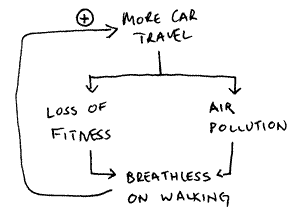Early Complications
A carbon addict will usually be either unaware or in denial of their addiction, considering their own high-carbon behaviours “normal”. As such, they are not likely to seek medical attention. However, retrospective studies have shown that a significant proportion of sufferers have had contact with medical services for related problems for many years before a diagnosis of CDS is finally made.
Since the early complications are both debilitating and reversible, it is important to be on the look-out.
Anxiety, stress (NB may result in marital discord).
A record 31 million prescriptions for antidepressants were dispensed in England in 2006 [6]. The rising prevalence of clinical depression has been attributed by some to greater awareness of the condition among patients and doctors. However, others have noted the correlation with rises in greenhouse gas emissions, and have raised the possibility of a causal effect.
(Note that a DEFRA report in July 2008 demonstrates that, despite the Kyoto Protocol, UK greenhouse gas emissions actually increased by 17% between 1992-2004, once emissions relating to nvConsumption are included.[5])
The proposed mechanisms include:
- • Lack of the well-known psycho-protective effects of physical activity & access to nature;
- • Longer, more stressful working patterns;
- • Loss of creative/leisure time;
- • Misdirected attempts to fulfil non-material needs (e.g. companionship) by carbon-intensive material means (e.g. purchase of a new iPod).
Reduced exercise tolerance
We are still awaiting formal studies into the correlation between carbon dependence and recovery time after exercise. In rich countries at least, the relationship may be complex: on the one hand lower levels of physical activity are found in households on low incomes (associated with a smaller carbon footprint)[7]; on the other hand, a sedentary lifestyle will often result from car (carbon) dependence. In practice, if your patient’s resting heart rate is above 76 per minute, an enquiry into car habit may be well worthwhile.
Respiratory symptoms
Carbon addicts are often to be found in asthma clinics, where a focus on inhaler technique or steroid dose may divert attention from the role of their carbon habit in “fuelling” the problem.
While doctor and patient are dutifully consulting the guidance on “stepwise” treatment of asthma, particle pollution, nitrous oxide and ozone from the car park may be creeping into the very clinic room itself, undoing their good work.
The size of the effect is not trivial; when traffic was reduced by 20% for the Atlanta Olympics, there resulted an immediate fall in ozone levels, along with immediate 11-44% reductions in healthcare visits for asthma attacks. After the Olympics, traffic and asthma levels returned to normal. [1]
Wheezing in children may be a manifestation of “Munchausen-syndrome-by-proxy” CDS, with some parents insisting on making short journeys by car “because the exhaust fumes on the roads make his/her chest worse”. This is a particularly effective strategy as the additional car travel not only contributes to poor air quality but may successfully expose the child to higher in-car pollutant levels.[2]
Similarly, carbon dependence can co-present with chronic obstructive pulmonary disease (COPD) generating an exceptionally intractable clinical syndrome (see Fig. 1).

Figure 1. Intractable syndrome produced by combination of carbon dependence with COPD.
Note that an equivalent syndrome is also found for carbon dependence with cardiovascular disease (CVD). CVD is now recognised as the major cause of morbidity and mortality from chronic exposure to air pollution.[3],[4]
Constipation
Does your constipated patient admit to a low fibre diet based on meat and processed foods? A sedentary lifestyle? Once again, screening for carbon dependence may lead swiftly to the root of the problem, and an early diagnosis could prevent many more serious complications.

